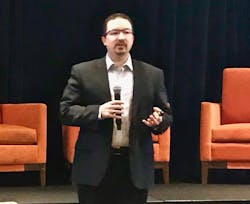In the world of automation technologies dominated by well-recognized names, the name Hitachi Vantara may not ring familiar. You’re likely aware of the name Hitachi from its many consumer technologies and the fact that it is the 24th largest manufacturer in the world with 140,000 employees and 193 manufacturing facilities in 21 countries.
But what is Hitachi Vantara?
The company supplies an array of products ranging from virtual storage and IT operations technology to data protection. Of greater interest to the Automation World audience is its Lumada Edge Intelligence, Manufacturing Insights, Maintenance Insights, and Video Insights products. This suite of technologies is aimed at the digital transformation of industrial companies.
Automation World previously covered insights from Hitachi Vantara around its digital twin technologies based on a presentation at the IoT Solutions World Congress event.
During ARC Forum 2020, Hitachi Vantara showcased the experience of two industrial customers—Ericsson and Logan Aluminum—which are digitally transforming their operations with Hitachi Vantara technologies.
Vijay Kamineni, business transformation leader at Logan Aluminum, said company management “knew we had to go digital to keep up. So we started our digital transformation journey 20 months ago from the understanding that we couldn’t rip and replace our existing systems. We started by using Hitachi Vantara’s Manufacturing Insights to balance man-machine time.”
Man-machine analysis looks at the relationship between the manual work performed by one or more operators and one or more machines involved in a manufacturing process to improve workstation output.
This focus on the balance of man/machine time launched Logan Aluminum’s digital transformation journey. “We didn’t have a digital transformation unit to start with, said Kamineni. “We’re set up as seven business units, each with its own tech systems. To coordinate this, we held a workshop with Hitachi Vantara and Logan Aluminum’s leadership to start the process, establish a vision, and start roadmapping around use-case optimizations to get our 1,400 people moving in one direction.”
As recently reported in an article covering Siemens co-creation process with its customers, Hitachi Vantara also employs a co-creation process to aid customers in their digital transformation and identify specific areas of value to target for tangible returns on investment.
Diverging from Logan Aluminum’s experience transforming brownsfield facilities through digitization, Ericsson is working with Hitachi Vantara at its new greenfield plant in Dallas, Texas. Henrik Soderlund, head of production at Ericsson, said, “We needed more global capacity, and that’s why we’re building this new factory. This factory was designed to be a showcase facility. We want to show what 5G can do in a manufacturing environment by demonstrating it in our own facility.”
Following highlights of Logan Aluminum’s and Ericsson’s work with Hitachi Vantara, each table in this session held a brainstorming discussion to identify the primary issues they’re looking to address in their digital transformation. The table at which I was seated focused on the top challenges faced by brownfield facilities. Present at the table were representatives from pharmaceutical and electronics manufacturing companies. Our brainstorming session yielded five key areas end users want digitalization to help them resolve:
- Limiting or eliminating unscheduled downtime;
- Driving organizational change management to move away from paper-based processes;
- Addressing compliance concerns, ranging from product specifics to health, safety, and environmental regulations;
- Translating ROI (return on investment) to value to justify digital transformation spending; and
- The ability to improve specific production efficiencies.
Like its customers, Hitachi is digitally transforming its own operations with its Lumada software (Automation World recently reported that Schneider Electric is digitizing its own factories with Aveva’s new Discrete Lean Management software.) Hitachi’s Omika Works’ use of Lumada software led to the factory’s recognition as a manufacturing Lighthouse by the World Economic Forum (WEF).
John Magee, head of marketing for digital solutions at Hitachi Vantara, noted the WEF has found that 70% of production data goes unused. That means “there’s still a lot of low-hanging fruit that hasn’t been captured across industry,” he said.
Leaders relevant to this article:



